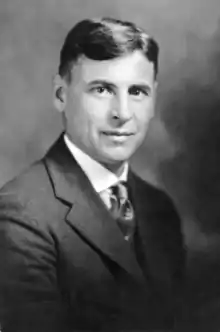Harry Gunnison Brown
Harry Gunnison Brown (May 7, 1880– March 11, 1975) was a Georgist[2] economist teaching at Yale in the early 20th century. Paul Samuelson named Brown in a list of "American saints in economics" that included only 6 other economists born after 1860.[3][4]
Harry Gunnison Brown | |
|---|---|
 Portrait of Brown | |
| Born | May 7, 1880 |
| Died | March 11, 1975 (aged 94) Columbia, Missouri, USA |
| Nationality | United States |
| Institution | Yale University University of Missouri |
| Field | Monetary economics Public economics |
| School or tradition | Neoclassical economics[1] |
| Alma mater | Williams College Yale University |
| Doctoral advisor | Irving Fisher |
| Other notable students | Beryl Sprinkel |
| Influences | George · Fisher · Davenport |
Early life
Harry Gunnison Brown was born in Troy, New York to Milton Peers and Elizabeth H. (Gunnison) Brown. He graduated from Williams College in 1904, studied at Ohio State University and he earned his Ph.D. at Yale University in 1909. While studying at Yale, Brown became a protege of Irving Fisher. Fisher was one of the pioneers in the development of mathematical economics and econometrics in the United States.[5]
On August 23, 1911, he married Fleda Phillips in Columbia, New York. While continuing his career in economics, he had three children: Cleone Elsa Brown, and Philips Hamlin Brown (29 April 1918 - 4 February 2019) and Richmond Flint Brown (April 5, 1925 - ).
Following the death of his first wife in 1953, Dr. Brown was married to Elizabeth Read Brown until his death in 1975.
He has three living granddaughters: Fleda Brown, Melinda Brown Putz, and Michelle Brown Griggs, and four living grandsons: Kirk Brown, Kevin Brown, Alan Luckey,and Roger Luckey. Two other grandsons, Mark Brown and Dennis Luckey are deceased.
Academic career
After receiving his Ph.D., Brown worked as an instructor under Irving Fisher in the economics department at Yale University until 1915. Brown held Herbert Davenport in high regard, and in 1915 Brown accepted a position under Davenport in the College of Business at the University of Missouri. Brown worked under Davenport for one year at Missouri, until Davenport left for a position at Cornell University in 1916. Brown remained at MU, and during his career he became chairman of the economics department as well as dean of the College of Business and Public Administration. Brown retired from MU in 1950.
For much of his career, he was mainly known North America's foremost advocate of the ideas of a land tax. He is described by Mason Gafney as having refuted:
- John Bates Clark's argument that the unearned increment was constructive
- Frank Knight's argument that land is like all other resources because it has an opportunity cost
- Richard T. Ely's argument that 'ripening costs' of land speculators justify urban sprawl.[6]
Economics career
Harry Gunnison Brown was known throughout the United States as a Georgist, and stood out as a staunch believer and advocacy of the ideas of Henry George, through a majority of his life he argued for tax reform along the lines proposed by George.
A well known area of specialization of Harry Gunnison Brown was that of taxation, specifically tax incidence. His text, The Economics of Taxation[7], was known as a benchmark for texts on the subject of Tax incidence.[8]
Works
Brown, Harry. G. (1931) Economic Science and the Common Welfare
McDonough, J. (1925). The Yale Law Journal, 35(2), 249–251. doi:10.2307/789527
References
- Ryan, Christopher Keith (1985). Henry Gunnison Brown: Economist (PDF) (PhD). Iowa State University.
- Brown, H. G. "A Defense of the Single Tax Principle." The Annals of the American Academy of Political and Social Science 183.1 (1936): 63-69. Quote: "The truth is that I recognize the fundamental justice and common sense of the single-tax idea. But that any other tax than a tax on land values is always and everywhere wrong, regardless of public needs or the nature of this other tax, I do not maintain."
- Ryan, Christopher Keith (1985). "Harry Gunnison Brown: economist". Iowa State University. Retrieved 7 January 2019.
- Samuelson, Paul (1966). The collected scientific papers of Paul A. Samuelson. Cambridge, Mass: M.I.T. Press. ISBN 9780262190800.
- Lissner, Will. "In Memoriam: Harry Gunnison Brown, 1880-1975". American Journal of Economics and Sociology. July, 1975.
- Gaffney, Mason (1998) Harry Gunnison Brown in The New Palgrave: A Dictionary of Economics (1987) edited by John Eatwell, Murray Milgate, and Peter Newman.
- Simons, Henry C. (1926-02-01). "The Economics of Taxation. Harry Gunnison Brown". Journal of Political Economy. 34 (1): 134–136. doi:10.1086/253744. ISSN 0022-3808.
- Backhouse, Roger E. (September 2004). "Christopher K. Ryan. Harry Gunnison Brown: An Orthodox Economist and His Contributions . Foreword by, Alfred E. Kahn. (Studies in Economic Reform and Social Justice.) xiv + 270 pp., illus., bibl., index. Malden, Mass./Oxford: Blackwell Publishing, 2002. $34.95 (paper)". Isis. 95 (3): 517–518. doi:10.1086/429033. ISSN 0021-1753.
Further reading
- Essays in Honor of Harry Gunnison Brown, The American Journal of Economics and Sociology 11(3) April, 1952
- Ryan, C. K. (1997). Harry Gunnison Brown's advocacy: the case he made for land value taxation 1917-1975]. The American Journal of Economics and Sociology, 56, 545–563.